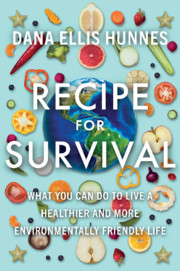Book contents
- Recipe for Survival
- Reviews
- Recipe for Survival
- Copyright page
- Dedication
- Epigraph
- Contents
- Figures
- Tables
- Foreword
- Preface
- Acknowledgments
- Introduction to Part 1
- 1 Agriculture Is a Major Driver of Climate Change (and Disease)
- 2 Politics and Dietary Guidelines
- 3 Overfishing
- 4 Plastic
- 5 Environmental Exploitation
- 6 Species Exploitation for Entertainment
- 7 The Positives
- 8 Part 2: Protecting Earth, One Recipe at a Time – An Introduction
- 9 Epilogue/Conclusion
- Appendix Recipes You Can Use
- Notes
- Bibliography
- Index
2 - Politics and Dietary Guidelines
Two Major Problems
Published online by Cambridge University Press: 06 January 2022
- Recipe for Survival
- Reviews
- Recipe for Survival
- Copyright page
- Dedication
- Epigraph
- Contents
- Figures
- Tables
- Foreword
- Preface
- Acknowledgments
- Introduction to Part 1
- 1 Agriculture Is a Major Driver of Climate Change (and Disease)
- 2 Politics and Dietary Guidelines
- 3 Overfishing
- 4 Plastic
- 5 Environmental Exploitation
- 6 Species Exploitation for Entertainment
- 7 The Positives
- 8 Part 2: Protecting Earth, One Recipe at a Time – An Introduction
- 9 Epilogue/Conclusion
- Appendix Recipes You Can Use
- Notes
- Bibliography
- Index
Summary
Current dietary guidelines in the US (2015-2020 (2020-2025 have not yet been published)) recommend too many portions of too many foods that are detrimental to both human health and the environment. The US-DGAs recommend relatively high intakes of meat, dairy, eggs, poultry, and fish, which are associated with an increase in the risk of several chronic diseases and also harm the environment (which was discussed more in depth in Chapter 1). Many Americans support having dietary guidelines that make recommendations concerning the environment and sustainability. The DGAC (Dietary Guidelines Advisory Committee) did in fact provide sustainability and food security recommendations for the 2015-2020 US-DGAs, which were almost entirely left out. Reasons for these omissions are often politically motivated due to the lobbying of various industries. This chapter makes the argument that having sustainable dietary guidelines that support human health and the environment first and foremost is more important than lining the coffers of various food and agriculture industries.
Keywords
- Type
- Chapter
- Information
- Recipe for SurvivalWhat You Can Do to Live a Healthier and More Environmentally Friendly Life, pp. 19 - 31Publisher: Cambridge University PressPrint publication year: 2022

